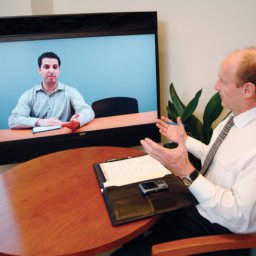Original Post by Denis Collins
Charisma is an intangible asset for a business person, right?. Maybe. It may be possible to cultivate charisma and learn to use it effectively in business meetings.
cha·ris·ma
kəˈrizmə/
noun
- compelling attractiveness or charm that can inspire devotion in others.
“she enchanted guests with her charisma”
synonyms:charm, presence, personality, force of personality, strength of character
- a divinely conferred power or talent.
Capturing intangibles is not as challenging a task as it may sound. Just ask John Antonakis, a professor of organizational behavior at HEC Lausanne, University of Lausanne in Switzerland. He and his team of researchers parsed charisma, which Merriam-Webster describes as “a special charm or appeal that causes people to feel attracted and excited by someone,” into 12 distinct behaviors and taught more than 30 business managers and students how to become measurably charismatic in a matter of a few months.
9 Verbal Charismatic Leadership Tactics
- Metaphors, similes & analogies
- Stories & anecdotes
- Contrasts
- Rhetorical questions
- 3-part lists
- Expressions of moral conviction
- Statements that reflect the group’s sentiments
- Setting high expectations for yourself
- Conveying confidence that goals can be achieved
3 Nonverbal Charismatic Leadership Tactics
- Body gestures
- Facial expressions
- Animated tone of voice
“These things are kind of invisible; they’re in the background,” he told the strategy magazine Business Insider. “People feel their consequence, but they don’t realize that the leaders are using them.”
And this subliminal presence typically has a positive transformative influence during business interactions. “[Charisma] makes people feel like the person who’s in charge will make the vision happen,” Antonakis said.
But charisma training isn’t the exclusive province of corporate executives. Because charismatic tactics are a mixture of verbal and nonverbal, anyone involved in business conversations can learn the techniques, sharpen the skills and apply them for greater influence in meetings – whether in-person, on the phone, over the internet or any combination of the three.
“Charismatic people can convey all kinds of emotional content” in many ways, media coach Ruth Sherman explained to Fast Company. “But what they do is they make you listen. They’re interesting enough regardless of what they’re saying, so you perk up and listen.”
Sherman highlights five conversation habits of charismatic people that you can apply to your business conferencing and collaboration tactics.
5 Conversation Habits of Charismatic People
1. Show Vulnerability
Everybody’s human, and no one is perfect. Yes, we all know these truisms. But becoming charismatic means learning to share specific examples of just how human and imperfect you are. Articulating your workplace struggles on occasion enables others to identify with you. Draw the line at continual complaining about your job, though.
2. Use Humor
But don’t over use it. Stand-up comedy has limited application in the workplace. Instead, Sherman suggests keeping a journal of funny stories suitable for flavoring business conversations and presentations. These anecdotes can be mundane events, issues and accidents that happen in everyday working life — perhaps the last time you gave your report during a conference call, but forgot to turn off “mute.”
3. Listen Intently
We’ve covered this skill in several posts. When conferencing and collaborating, other work activities should be put on hold. Pocket your smartphone. If you bring a laptop or tablet to a meeting space, avoid looking at your screen when someone’s talking – unless your role is acting as scribe. If you anticipate a legitimate interruption – such as an important call – let colleagues know before the conversation begins.
4. Use Your Hands
Whether face-to-face, audio-only or online, body gestures can be conversational complements that boost charisma. Even if everyone involved in a meeting can’t see what you’re doing, engaging yourself physically can boost your confidence – and, therefore, your performance. (See our post about “standing like Superman.”) But keep in mind that, in any situation, your hands should add meaning to your words rather than detract from them. Sherman advises avoiding positions that appear insecure — e.g., folded across your chest or behind your back. If you don’t normally talk with your hands, no problem — just drop them to your sides or keep them resting comfortably on the table.
5. Make Eye Contact
Maintaining eye contact is a good way to assert control, Sherman says. But monitor your intensity. Staring into someone’s eyes for a long time can feel aggressive rather than inviting. Likewise, looking down or past people can seem shy and unassertive. Strike a balance by looking away from time to time, but come back soon for brief, meaningful instances.
Because the term “charismatic” so often is applied to celebrities, pundits and politicians, associating charisma with grabbing attention or trying to change world is understandable. In the business content, however, refining your charisma is about making your project, team or organization a little better one conversation at a time. Remember, it’s not just what you say, it’s also how you say it that matters in the long run.




